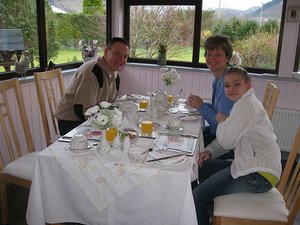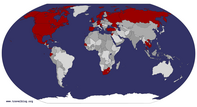Advertisement
Published: June 12th 2017

 Breakfast at the Rustic View Inn, in Ft. William
Breakfast at the Rustic View Inn, in Ft. William
There should be a clear view of Ben Nevis mountain over my right shoulder.Geo: 57.2725, -5.73323
Our B&B in Ft. William was noted for having spectacular views of Ben Nevis, which is the highest mountain on the British Isles. With the low-hanging clouds, however, we had no viewings. Our host showed us some photos, proving that there was in fact a very large mountain right outside our window. With the past luck we've had seeing notoriously hidden peaks before -- Mt. McKinley in Alaska and Mt. Robson in British Colombia -- we could not be too disappointed at not seeing Ben Nevis.
Our day started exactly as the previous had ended, with a visit to another castle. This one -- Old Inverlochy -- dates back to the 11th Century, is primarily ruins (understandably), and was only a couple blocks from our B&B. The low clouds, misting rain, neighboring graveyard, and swarms of cawing crows all made for a very spooky visit.
For those Harry Potter fans out there, the Jacobite Steam Train runs from Ft. William westward, and was used as the famous Hogwarts Express in each of the Potter films. We were told that the train line now draws thousands of visitors a year, while it is actually much more scenic to drive the road that
runs alongside the train tracks -- which is for what we opted. A particularly scenic raised rail viaduct was used in the movies, and that is located directly across from a famous landmark -- and another pilgrimage site for Scottish independents -- Glenfinnan. This was the site where Prince Charles Edward Stuart (Bonnie Prince Charlie) announced his infamous Jacobite uprising in 1745. Charlie's father had been heir to King James II of England, Scotland, and Ireland. He was the last Catholic king in Britain -- the one driven out by William of Orange, and associated with the massacre at Glencoe. Anyway, the current king of England (George II) was in fact of German heritage (the Hanoverians). Charlie raised support among the Scots to restore a Stuart (his family) to the throne, and he started his short-lived rebellion. He was to lose miserably eight months later -- at Culloden, which we also visited -- but had he been a better tactician and less stubborn, his rebellion may have succeeded -- and who knows what that might have done for American Independence, as King George III became king in 1760....but I digress. We visited the memorial and, right before we left, a

 Glenfinnan Monument to Bonne Prince Charlie
Glenfinnan Monument to Bonne Prince Charlie
Sight where he declared his uprising against King George IItrain crossed the viaduct and we got some pictures. Alas, it was a commuter train -- not the steam train used for the Harry Potter rides -- but picturesque nonetheless.
At this point, the sky was clearing and the true beauty of the surrounding countryside was becoming apparent. The following hour-long drive do the ferry terminal at Mallaig was perhaps the most scenic of our entire trip. We were, however, trying to make the ferry, so I was driving a tad fast and we missed several scenic overlooks, to be sure.
We made the ferry -- narrowly -- and a short ride to the Isle of Skye (10 miles off the coast) followed. Skye is the largest and northern most of the Herbrides islands, though it only has around 6,000 inhabitants, half of whom live in one city. The island was devastated by the "clearances" of the 18th and 19th centuries, during which England tried to destroy the Scottish clan system and protect landlords. Thousands of people were forcibly evicted from land they had farmed as tenants, or under the protection of clan chiefs. This was the highest period of Scottish emigration to America. The island is almost completely devoid of
trees and has a completely alien look about it; as Katherine and I drove over to the western side during the afternoon, it felt as though we were on the moon.
As we drove north from the ferry terminal, the ladies in the car announced that it was time for tea. Seeing as there was nothing around -- aside from numerous castle ruins scattered about -- that was going to be a tall order. As we drove around a large bend in the road, we could see a pure-white house in the distance, sitting atop a promontory where a small river emptied into an inlet. The setting was spectacular, but also generated a universal "what do you do, if you live out here in the middle of nowhere." At the same time, we spotted a small sign for a place serving warm food, quickly followed by another sign advertising tea. I obediently turned where indicated, and we were immediately on a dirt road -- two tire tracks, really -- that led across what appeared to an almost improvised bridge and into about the only thicket of trees on the island. That led to a gate and emerged into a gravel
parking lot -- you guessed it -- the same white house we'd seen from the bend in the road. There were no signs nor people, that we could see, but the view was stunning. We tentatively made our way into the house, and Anna was given a very formal greeting, and asked "what might we be doing for you today, my lady?" We asked for tea, and were led into a incredibly cozy drawing room, complete with a roaring fire and a sofa into which I literally sank. The room was full of family photos, which many photos of elegantly dressed women and kilt-wearing men in front of a series of castles. Two waiters were immediately upon us and presented a menu for high tea. When we saw the price of 18 GBP ($30) for one service of tea, we should have realized something was up. As the only people in the building, we explored, and found a small gift shop (full of Claire MacDonald food items and cooking utensils), an intimate yet stately dining room, and a larger but equally as cozy drawing room as the one in which we'd settled. We were to eventually realize that we had

 Jacobite Steam Train Viaduct
Jacobite Steam Train Viaduct
Used in the Harry Potter Films"stumbled" upon a Michelin-starred restaurant called Kinloch Lodge, owned by Lord and Lady MacDonald. We learned later that Claire MacDonald (literal lady of the house) is somewhat like Martha Stewart in Britain, with a television show and regular food columns. We opted for two services of tea, which was more than enough food and drink for us all. In fact, we left several cakes untouched. It was a truly memorable meal.
We arrived our our hotel for the night about 30 minutes later, in the tiny town of Kyleakin, which sits on the northeast corner of Skye, in the shadow of the relatively new bridge which connects Skye to the mainland. Upon checking in, we mentioned we'd stumbled upon Kinloch Lodge for tea; our innkeeper lifted her nose, improvised a queen-like accent, and asked said, "My, my...how posh....and how was Lady Macdonald?!" She was the one who filled us in on Macdonald's culinary fame. Interesting enough, she's not the chef, though I guess her celebrity helped attract a Michelin-starred chef to her hotel in the middle of nowhere.
Jane wished to rest for the afternoon, and Anna was steeped in a good book and asked to stay behind and "babysit Grandma," which
left K and I free to explore the rest of the island. We had grand plans to drive across to -- wait for it -- another castle, then hit the main town of Portree, and drive a cliff-side road on the northern tip. It was evident as we left Kyleakin, however, that while small, it was going to take a very long time to cover some of these distances, given the layout of the few roads. We reached Dunvegan Castle on the western edge, which is the oldest continually occupied palace in Scotland and home to chief of Clan MacLeod for more than 800 years. There must be a lot of MacLeods (and their descendants) in the U.S., as they had a healthy contingent at the castle.
We made it to Portree around 5:00pm, and all of the shops had already shut for the night. In fact, many may never have even been open, as we were told that the tourist season doesn't even begin until after Easter. It was a nice little town, nonetheless, and worth seeing. Our drive back to Kyleakin took longer than anticipated, and we expected to find Anna and Jane worrying about it when we
returned. That was unfounded concern! Anna had finished her book and started a new one, and Jane had just woken up from a nap. We had dinner at Saucy Mary's restaurant, which was far tamer than its name might have suggested. The restaurant had several tables full of tourists, while the much larger bar area was overflowing with locals. We had to order food and drinks at the bar, and they brought them over. In talking to bar maid, both K and I had to ask her several times to repeat herself, as her accent was incredibly heavy, even for Scotland. As we listened, we noted too that many people in the bar were speaking Gaelic to each other. We later learned that more than a third of people on the island speak Gaelic as their first language, and more than half of the children attend Gaelic-only schools. The fact that the fishing boats were moored across from the restaurant explained by such a modest establishment had such outstanding seafood. Anna, who is a true connoisseur of salmon, pronounced her simple steamed salmon as the best she'd ever eaten. That recommendation might be worth more than a Michelin star.
Advertisement
Tot: 0.149s; Tpl: 0.014s; cc: 12; qc: 53; dbt: 0.056s; 1; m:domysql w:travelblog (10.17.0.13); sld: 1;
; mem: 1.2mb





















